Coast Artillery: Armament
The guns of the coast artillery were built to match those carried by the warships of the era. The modern era seacoast guns were emplaced in protected concrete structures and were generally more accurate than those carried on the warships, the seacoast artillery could cause more damage to the ships than they could inflict on the defenses. As most nations did not want to risk damage to their expensive naval ships, the presence of seacoast artillery could deter an enemy fleet from attacking.
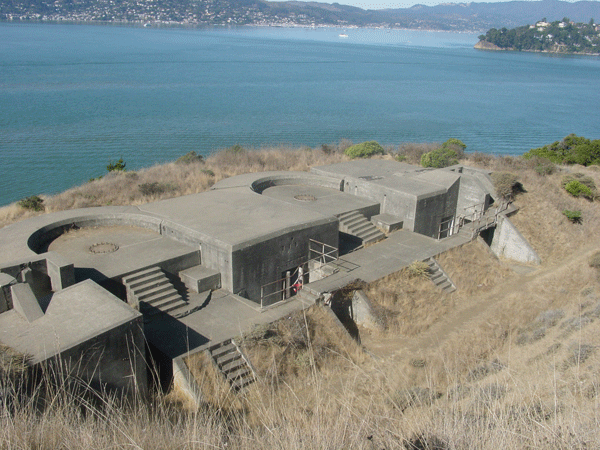
Battery for two 5-inch pedestal mount guns: Battery Ledyard, Fort McDowell, Harbor Defenses of San Francisco (2006)
The term battery originated from the tactical organization of artillery units. Its simplest and most accurate definition is one or more pieces of artillery which are under the command of a single individual and intended to concentrate their fire on a single target. In the American Army, the term also applied to the artillery corps unit that was the equivalent of an infantry company. An artillery battery would ideally be the complement of men required to man a designated gun battery. By the turn of the century, in the modern era harbor defense construction programs, the term battery was used to describe a set of guns under a single commander together with the entire structure erected for the emplacement, protection, and service of those guns. Today we apply the term battery to those structures which were built to hold seacoast artillery, even though their guns (and thereby the original definition) have long since been removed. The modern era seacoast gun emplacements were fairly complex structures that had specialized terminology that was all its own.
Battery Names The large number of detached gun batteries built during the 1890s quickly became difficult to keep track of. Therefore, beginning in 1902, the War Department assigned names to each battery. The batteries were most often named to honor deceased individuals who had served the nation with distinction, though there were many exceptions. Many of the batteries were named after army officers who had been killed in action or who had died recently, but a few were named after famous Indian chiefs, governors, and localities. Some structures, while physically a single unit, were divided into two (or more) tactical batteries at one time or another, each with its own official name. Many mobile gun batteries were designated by their locality or the name of their battery commander.

Restored power room at Battery Osgood-Farley, Fort MacArthur Museum, San Pedro, CA (Joe Janesic)
For more details on official fort and battery names, see Designating US Seacoast Fortifications, War Department General Orders and Letters from the Adjutant General 1809-1950, compiled by Matthew Adams, privately published by the compiler, Australia, 2000.
A modern-era seacoast gun battery had everything it needed to support its weapons: magazines for the storage of shells and powder and the facilities for transporting the ammunition to the guns. Larger batteries had day rooms for the staff, latrines, storage rooms, plotting rooms, and observing stations. All batteries after 1900 or so received electrical power for interior and exterior lights. All forts and some of the larger batteries had their own electrical power generator systems. The post 1920s gun batteries had weapons which required electric power as well.
SR – shell room ——- MG – motor generator room
M – powder room —— P – plotting room
IT – indicator tunnel ——RSB- radio & swtitchboard room
TC – truck corridor —— S – store room
PR – power room —— L – latrine
T – transformer room —— OR – officer room
RR – radiator room —— RT – rear tunnel
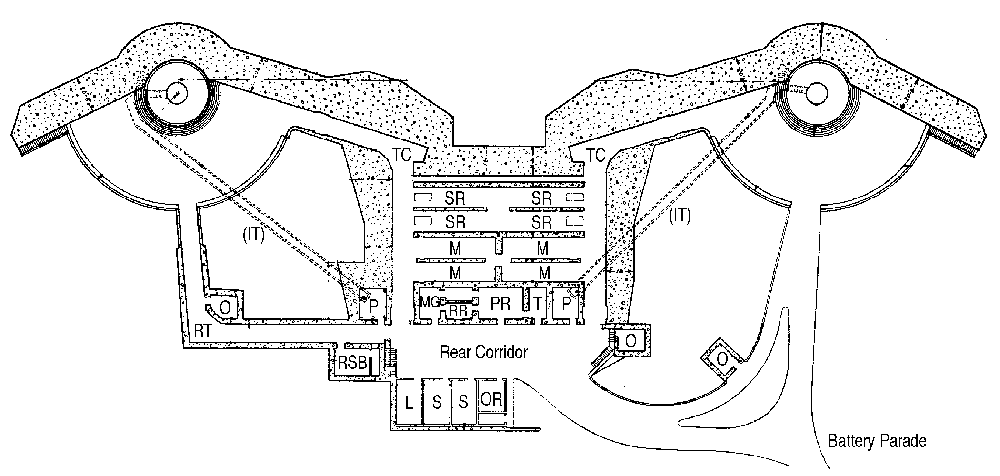
Layout of an American seacoast 14-inch gun battery built 1915-19 (Battery Osgood-Farley, Fort MacArthur, CA)
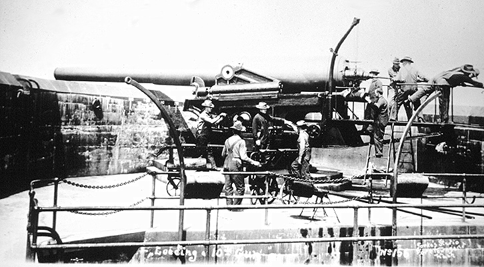
10-inch gun on model 1892 barbette carriage
Cannon: The modern (or breech-loading) era of American artillery began with the development of new rifled breech-loading guns in the late 1800s. The guns used to defend the American coastline were designed by the Ordnance Department of the U.S. Army. These cannon were termed either mortars, howitzers, or guns, depending on their tube length and a few other parameters. They were also classified as
- Primary (16, 14, 12, 10-inch) for use against capital ship with similar armament
- Secondary (8, 6, 5, 3-inch) for use against smaller, faster, lighter armed ships and minesweepers.
Carriages were either fixed (permanently emplaced in a prepared position), or mobile (i.e. had wheels or tracks).
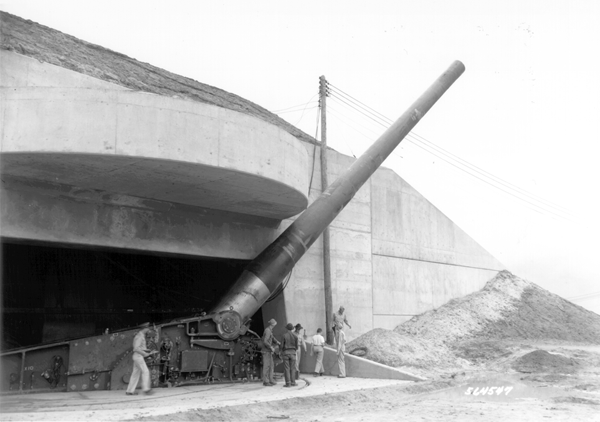
16 inch gun on model M4 barbette carriage in casemate
Barbette carriage (BC) A carriage arrangement in which the gun was fired over a parapet. The carriage was comprised of a set of frames or cheeks which supported the gun tube in a manner that allowed for elevation and depression, on a base that accommodated the firing recoil and that could be moved horizontally. Only a few of these early designs were made for the 8, 10, and 12-inch guns by the early 1890s when the disappearing carriage design was adopted for the heavy seacoast artillery guns.

6-inch gun on model 1900 pedestal mount
Barbette carriage (long-range) (BCLR) A new barbette design of the World War I period allowed for greater firing elevations and ranges for largr caliber guns. It eventually became the standard American seacoast artillery carriage for 6-inch, 8-inch, 12-inch, and 16-inch guns, and these carriages have collectively become known today as barbette carriages (long-range). During World War II new 16-inch BCLRs were protected by modern concrete casemates, while the new 6-inch BCLRs were protected by thick steel shields.

3 inch AA gun on M1917 pedestal mount
Pedestal mount (Ped.) Carriages designed for guns of 7-inch or lesser caliber (the Army guns were generally 3-, 5-, and 6-inch guns). This type of mount consisted of a fixed cylindrical base on top of which rotated the yoke which held the cannon in a cradle equipped with recoil absorbing cylinders. Most pedestal mounts had a frontal shield.
Antiaircraft mount (AA) When antiaircraft gun carriages were developed following World War I, they were technically pedestal mounts, but were always were referred to as AA mounts.
Mortar Carriage (MC) Mortar mounts for firing short 12-inch calibur weapons in high arcs.
Fixed Retractable Carriages
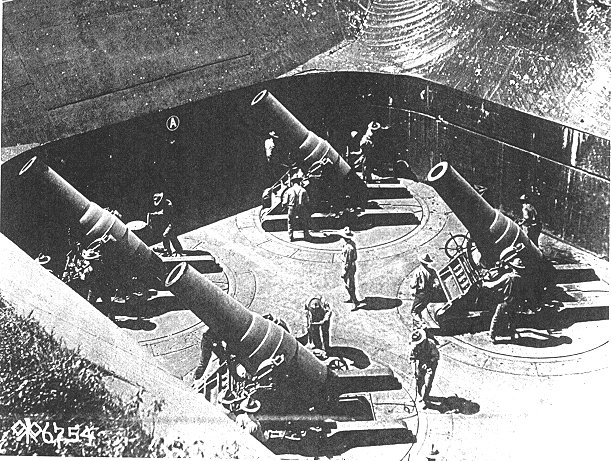
four 12 inch mortars on model 1896MI carriages
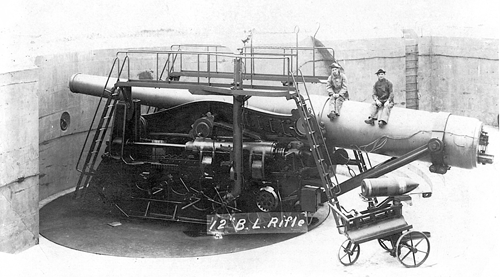
12-inch gun om M1897 disappearing carriage
Disappearing Carriage (DC) The prevalent carriage design for heavy American seacoast guns in the period between 1890 and 1917, of which large numbers were constructed and installed. These were further designated, as were all carriages, as either limited fire (LF) or all around fire (ARF) with regard to their traversing abilities. The guns were mounted on one end of a pair of swiveling arms which were counterweighted at the other end. When the catch was released after loading, the falling counterweights would raise the gun to firing position, and the recoil energy of firing would push the gun back down to the loading position. The US Army used this mount for 16-, 14-, 12-, 10-, 8-, and 6-inch guns)

Balanced Pillar Mount (BPM) A trade name for an early modern era retractable carriage for the 5-inch gun which allowed the weapon to be lowered into its emplacement between drills or engagements. The gun and gunners platform rested on a telescoping tube which could be manually cranked up or down.
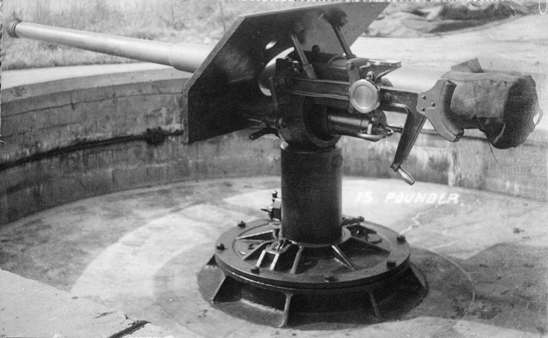
Masking Parapet Mount (MPM) Somewhat similar to the balance pillar mount, this mount for the 3-inch gun was designated by the trade name used by the manufacturer.
Mobile CarriagesThe mobile coast defense weapons of the post-World War I era were from stocks of weapons originally designed and built for use in European Theater. The availability of these weapons, the new emphasis on mobility in seacoast defense, and the lack of funding for new fixed coast artillery guns, brought a mobile era to coast artillery in the period between the wars.
Railway mount (RY) Several American railway mount designs
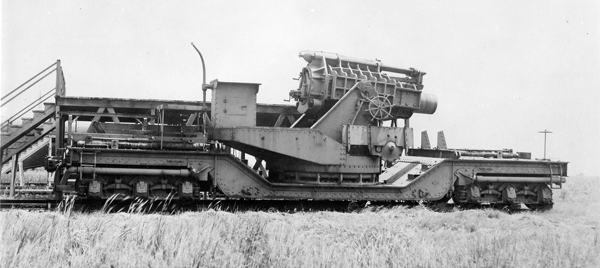
12-inch mortar on railway mount
were developed during World War I, most utilizing weapons removed from the existing coast defenses. The most numerous of these remounted weapons were 8-inch guns (on a M1918 BC) and 12-inch mortars, both of which were eventually used for coast defense. A few designs for new 14-inch guns were developed and built by the Navy for use in Europe. The US deployed four Army-built 14-inch guns on railway mounts, two in Panama and two at Los Angeles.
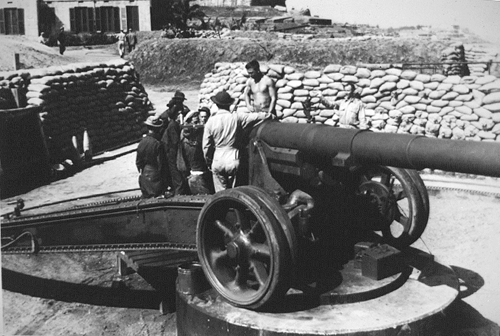
Tractor-drawn mount (TD) Also left over from the war were a great number of truck (initially tractor)-drawn artillery pieces which could be moved along roads. The most numerous of these was a 155 millimeter gun, an American-built (M1918) version of a French 1917 design. This became the standard tractor-drawn coast defense weapon, and with some modifications to the carriage and the addition of pneumatic tires, remained in service through World War II. The guns could be set up to fire at any location by preparing an earthen Field Mount (FM). During the 1920s a simple circular concrete platform was developed in Panama for this gun, and these were called Panama Mounts (PM). Many PMs were built for 155s which were used as temporary defenses at the beginning of World War II.
Click this link to see photos of existing American seacoast artillery
| Fort | Battery | #guns | calibur | carriage | max. range |
| Stevens | Lewis | 2 | 10-inch | disappearing LF | 14,000 yds |
| Walker | 2 | 10-inch | disappearing LF | 14,000 yds | |
| Mishler | 2 | 10-inch | disappearing ARF | 14,000 yds | |
| Russell | 2 | 10-inch | disappearing LF | 15,000 yds | |
| Clark | 8 | 12-inch | mortar | 12,000 yds | |
| Pratt | 2 | 6-inch | disappearing LF | 14,000 yds | |
| Freeman | 2 | 6-inch | pedestal | 16,000 yds | |
| & | 1 | 3-inch | masking parapet | 11,000 yds | |
| Smur | 2 | 3-inch | masking parapet | 11,000 yds | |
| Canby | Allen | 3 | 6-inch | disappearing LF | 14,000 yds |
| O’Flyng | 2 | 6-inch | disappearing LF | 14,000 yds | |
| Columbia | Ord | 3 | 8-inch | disappearing LF | 12,000 yds |
| Murphy | 2 | 6-inch | disappearing LF | 14,000 yds | |
| Crenshaw | 3 | 3-inch | masking parapet | 11,000 yds |
| Fort | Battery | # guns | calibur | carriage | range |
| Stevens | Russell | 2 | 10-inch | dissapearing LF | 15,000 yds |
| Clark | 4 | 12-inch | mortar | 12,000 yds | |
| Pratt | 2 | 6-inch | disappearing LF | 14,000 yds | |
| Canby | Guenther | 4 | 12-inch | mortar | 12,000 yds |
| Allen | 2 | 6-inch | disappearing LF | 14,000 yds | |
| Columbia | Murphy | 2 | 6-inch | disappearing LF | 14,000 yds |
| Fort | Battery | # guns | calibur | carriage | range |
| Stevens | 245 | 2 | 6-inch | shielded barbette LR | 27,500 yds |
| AMTB #2 | 2 | 90 mm | fixed | 19,500 yds | |
| & | 2 | 90 mm | mobile | 19,500 yds | |
| $ | 2 | 37 mm | mobile | ||
| Canby | 247 | 2 | 6-inch | shielded barbette LR | 27,500 yds |
| AMTB #1 | 2 | 90 mm | fixed | 19,500 yds | |
| & | 2 | 90 mm | mobile | 19,500 yds | |
| & | 2 | 37 mm | mobile | ||
| Columbia | 246 | 2 | 6-inch | shielded barbette (not armed) |

